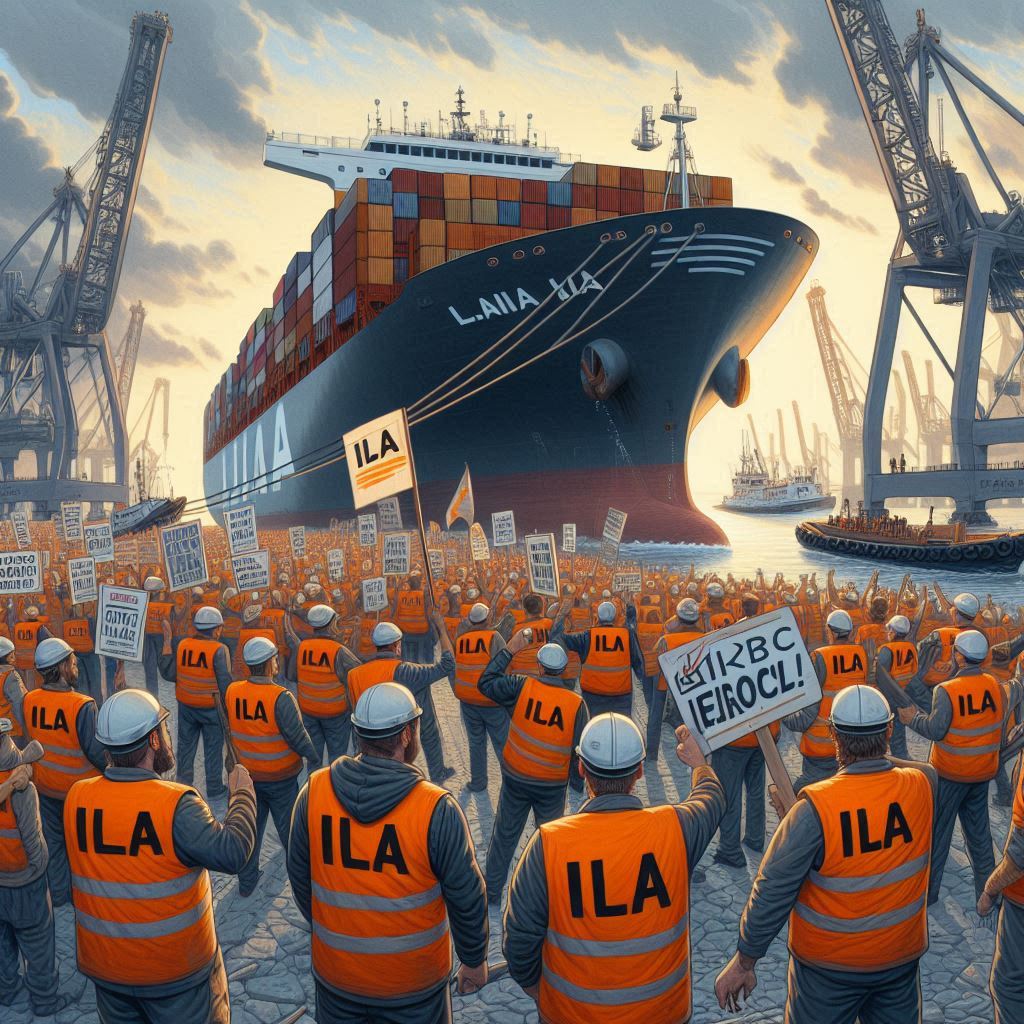ILA Strike Aftermath – It’s Not Over Yet & Wage Agreement May Become Problem
You might have thought the drama at the ports and the disruption threat to U.S. supply chains was over, but it’s not…
After shutting down the East and Gulf Coast ports for three days last week with a strike, the International Longshoremen’s Association (ILA) made a tentative agreement with their employers, represented by the United States Maritime Alliance (USMX), on wages. With an extension of the previous master contract in place for the ILA to resume work at the ports, the USMX is on a 90-day clock to work out a new master contract with the union.

Could that clock wind down with no new contract? Could there be ILA slowdowns at East and Gulf Coast ports like the International Longshore & Warehouse Union (ILWU) slowdowns of West Coast ports we regularly see during contentious contract negotiations on the other side of the country?
If the strike itself wasn’t enough, union rhetoric during the lead-up to the strike made it crystal clear things are already very contentious between the ILA and USMX. Things are not set up to be amicable when the parties finally return to the negotiating table. Just getting to the table has been impossible since the ILA cancelled talks in Junes and refused to reschedule before going on strike October 1st. Now, the USMX and ILA have difficult issues to work through at what’s likely to be a frosty table for talks.
The biggest and most contentious issue for the parties to reach agreement on is likely automation. However, union jurisdiction is another issue that could cause problems. Even the tentative wage raise agreement may not be as strong of an agreement as it first appeared to be. Because of how that agreement was reached, it could come back to plague negotiations.
Peter Tirschwell reported in a Journal of Commerce (JOC) article:
The deal on wages that ended the strike was merely “provisional,” according to one management source, just one element of those several others that still need to be negotiated between now and the new deadline of Jan. 15.
What Happened Behind the Scenes to End the ILA Strike
The parties, or at least the USMX, seem to have been forced into the wage agreement by the Biden/Harris Administration because a protracted ILA strike would likely hurt Vice President Harris’s presidential campaign. The administration scored a big political win in getting a pretty quick end to the strike, even if it only kicked the can of port disruption down the road past next month’s election.
For an administration with very few wins during its time in office, it has managed to find them in crucial moments for Democrats when it comes to union strikes. The Biden/Harris Administration used a similar kick-the-can-down-the-road approach to push a rail workers strike in 2022, which was thought to be a potential disaster for Democrats running for office, past the mid-term elections. In the end, a very likely-looking strike that would have crippled U.S. supply chains never materialized.
Unfortunately, the Biden/Harris Administration ignored the strike threat from the ILA too long to prevent it from happening altogether. Then again, maybe they didn’t want to stop it completely. The Teamsters union broke its tradition of endorsing the Democrat nominee for president after it polled its members and discovered they supported President Trump over Vice President Harris nearly two-to-one. The strike, as long as it was short, gave the Biden/Harris Administration the chance to pander to the unions, which play a role in the Democrat electoral machine.
Playing to the union meant painting the USMX as the bad guy. And the Biden/Harris Administration treated the employers at the ports as such while pressuring them into a deal that would make them bend even more when they’d already been the only ones to bend on the issue of wages.
It would not be surprising if the USMX is bitter about how the wage agreement went down, adding even more contention to negotiations when they start back up over this 90-day window.
The JOC article quoted above is worth reading in full, especially for Tirschwell chronicling how the wage deal went down with the Biden/Harris Administration. The administration went on a two-week campaign to pressure the USMX to increase its approximately 50% wage increase offer, which it was holding firm on after previous offer increases, to a 62% wage increase offer. At the forefront of the administration’s intensifying pressure, from a phone call to senior-level meetings to CEO-only conference calls with summonses to Washington, was politics and union rhetoric, Tirschwell reports:
Throughout the series of meetings, according to sources, Biden administration officials consistently voiced the same or similar messages as that of the union: basically, that because carriers earned record profits during the pandemic, it is their duty pay up to avoid further disruption at the ports.
Ever-present, officials said, was the upcoming presidential election and what appeared to be a determination by the administration to avoid a politically damaging distraction in the final weeks of the campaign, which is what they feared from a protracted strike.
It’s unknown what the administration said to USMX executives in the CEO-only conference call that included the short notice summonses to Washington. However, the tentative wage deal was completed quickly after it ended. President Biden did make a not-so-veiled threat on members of the USMX when he spoke publicly on the situation after ILA went on strike. Like a union rep instead of president, he accused the USMX of refusing to negotiate a fair wage and said his administration “will be monitoring for any price gouging activity that benefits foreign ocean carriers.” By the reaction and speed of the deal, it seems likely similar or even more intense threats against the USMX were made in the conference call.
East & Gulf Coast Ports Set Up for West-Coast-Style Contentious Contract Negotiations
Forced into what the USMX must feel like is a bad tentative deal, it’s hard to imagine the USMX bending to other union demands in negotiations. And Tirschwell’s sources are saying as much:
With the 62% wage increase being an unprecedented offer to the union, the USMX will be hard-pressed to give in on other key demands the ILA is making, sources say, especially as the offer merely reinforces the longstanding disconnect in the view of ocean carriers between high US port costs primarily driven by longshore labor and low productivity.
The biggest demand the ILA has made publicly is no automation of any kind at the ports. That would be a major step backward from the restrictive language on automation the union and USMX previously agreed to in the former contract. The USMX argues technological advancement through automation at the U.S. ports is necessary to increase their comparative productivity, which lags behind that of major ports around the world.
There’s a fight brewing on that issue that alone. When the union doesn’t get what it wants in negotiations, labor action often ensues. That means things could still get very ugly at the ports. But at least, for the Harris campaign, things shouldn’t boil over before the election. Hopefully for shippers, and all of us, cooler heads will prevail when the ILA and USMX are actually sitting together at the negotiating table over the next 90 days. Importing and exporting has likely just become more expensive because of the tentative wage deal. Let’s not add more disruption expenses to it.
ILA Strike Lead-Up & News
ILA Already Threatening Strike
ILA Stance Is Worse Than Just Threatening Strike
We Have to Talk About the ILA Strike Threat
How to Prepare for Potential ILA Port Disruption
No One Knows What Will Happen with ILA Port Disruption
Early Peak Season, High Freight Rates, & 5 Factors Shaping Ocean Freight Shipping 2024
ILA Strike Watch 2024: Cancelled Talks & Strike Threat Increase
Are There Any Signs the Early Peak Season Is Slowing Down?
ILA Strike Watch 2024 – US Trade Groups Ask Biden to Get ILA to Negotiation Table
ILA Strike Watch 2024: Biden No, Trump Yes?
ILA Strike Watch 2024: ILA Says Strike More Likely
ILA Strike Watch 2024: Union Rejects Wage Offer & Prepares to Strike
ILA Strike Watch 2024: With 1 Month Till Strike, ILA Flips on Mediation
ILA Strike Watch 2024: ILA Announces Unanimous Support for Strike
ILA Strike Watch 2024: Will White House Stop Strike?
ILA Strike Watch 2024: Biden Won’t Stop Strike
Shipper Alert – ILA Strike Is On!
ILA Strike – Biden Plays Union Politics Instead of Protecting U.S. Economy
ILA Strike – Secretary of Labor’s Unbelievable Statement About Negotiations





